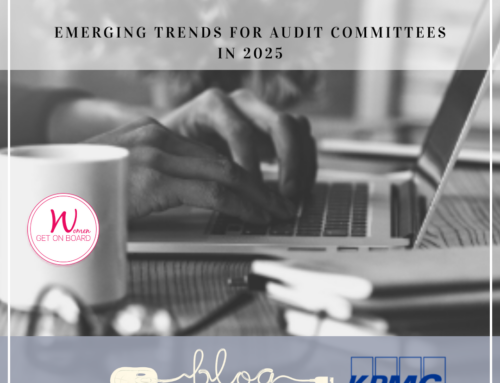Women Get On Board Inc. (WGOB) is a member-based company that connects, promotes and empowers women to corporate boards.
On September 28, WGOB hosted their virtual Speaker Series, which UBS sponsored. In an engaging fireside chat, experts discussed the board’s role in creating a healthier, more sustainable planet by integrating environmental initiatives into core business strategy.
To begin the event, Deborah Rosati, FCPA, FCA, ICD.D, Corporate Director and WGOB Founder and CEO introduced Aneliya Crawford, Managing Director at UBS Investment Bank and leader of UBS’s ESG Advisory Group efforts for the Americas.
Then, Aneliya welcomed Sarah Keyes, CEO of ESG Global Advisors Inc., to start the conversation. Sarah is an ESG and climate change expert with over a decade of experience. Today, she regularly presents to executive teams and boards of directors on the link between ESG and climate change with performance and long-term value, and helps her clients establish ESG and climate change strategies.
Sarah kicked off the discussion by emphasizing the urgency of climate issues in the international community.
“We’ve only got about seven years left to cut global emissions by half,” she said.
She underscored that companies and governments must work to meet the 2030 targets established in the Paris Climate Agreement to prevent environmental catastrophe on a global scale. She also pointed out that not only high-emitting sectors will be impacted. Research shows that as much as 90% of public equities could be affected by climate change in some way. As a result, boards in every sector must pay attention to environmental issues and take action to address climate change.
What is the role of the board on environmental issues?
Over the past few years, most leading companies have established their own climate targets, and many have even begun disclosing climate data to stakeholders. However, although targets and disclosure are excellent steps toward sustainability, there is still a lack of clarity around who is responsible for ensuring that companies meet their established climate goals.
“The first piece of this is for corporations to put their house in order, to decide structurally and internally who takes charge of these issues,” said Aneliya.
Most directors know that it is the board’s responsibility to lead major changes in the organization. However, board leaders may be unsure how to drive forward action on environmental issues within the confines of their role.
Sarah’s advice? Best practice is for the entire board to be responsible for environmental concerns—meaning every member and every committee. In practice, that means that all board members should be knowledgeable about climate change and environmental issues, and these topics should play a role in every decision the board makes.
An integral element of this strategy takes place at the committee level. All committees should be incorporating climate thinking into their duties. Audit committees should adjust their mandates, with explicit requirements to include external oversight of climate issues. On governance and nominating committees, board members should incorporate climate mandates into their processes to ensure the board will have the necessary expertise to act on environmental concerns in future years. And when climate targets are established, compensation committees should explore how they can tie environmental targets to executive compensation plans so that leaders are held accountable for meeting them.
For most companies, it is not necessary to establish a dedicated sustainability committee, as it often silos the issue. However, in the case of high-emitting companies, it may be necessary to form such a board committee, as there will be an array of complex concerns to address.
In addition to addressing climate issues within board committees, Sarah recommended implementing ESG steering committees at a management level—comprised of multi-disciplinary teams from human resources, operations, finance and legal. Steering committees can help to put environment plans into action, prevent silos, encourage cross-functional conversations, and ensure accountability in each function.
What is the role of ESG/sustainability departments?
Many companies have invested in hiring ESG or sustainability professionals and some have even created whole departments dedicated to the issue. This can be a great step, particularly for high-emitting companies, but too often, such departments are often relegated to only recording data and generating reports.
Aneliya pointed out that simply reporting on sustainability is no longer adequate. If environmental experts are not integrated into business operations and empowered to set strategy, they are not able to fulfill their role.
Sarah agreed. She said she often tells clients, “Don’t let the ESG reporting wag the dog,” meaning that companies should establish an ESG strategy first, then generate reporting, rather than the other way around.
“The ESG report is simply an output of a well thought out ESG strategy,” she said.
What are the opportunities?
Although much of the conversation around climate change is focused on the risks, there are also opportunities, particularly within the green energy transition.
“I find that not enough emphasis is being put on the gross opportunities—the upside,” said Aneliya.
Right now, companies have the chance to position themselves as leaders on environment issues to win new customers and get a leg up on competitors. In Canada in particular, there is a significant opportunity to show the world what sustainable development can look like in a resource-based economy.
Board directors should look towards the future and consider the new opportunities appearing as the world moves towards net zero. One of the most direct ways to explore such opportunities is to incorporate a climate change lens into the organization’s strategic planning process.
How should boards engage with stakeholder expectations on sustainability?
There is often a disconnect between investors—who have been leading the charge on environmental issues—and boards. To mend the disconnect, board foresight is key. Recognizing the urgency of the issue, board members should look ahead to anticipate future concerns that will matter to stakeholders, as well as potential opportunities for innovation.
Aneliya raised the example of car manufacturing. As of this year, every major car company has released a plan to convert their entire fleet to electric vehicles. However, many stakeholders in the industry are aware that the planet doesn’t have a large enough lithium supply for every car company to make the switch. The companies who will win the transition to electric are the ones that built strategies to back up their pledges, incorporating supply chain factors and other concerns. Investors will be paying attention to which companies include this level of detail into their climate plans.
Boards should also be practicing an engagement-first approach to investor relations. The recent upheaval at ExxonMobil is a prime example of what happens when boards are not in touch with their stakeholders and their concerns.
What’s the board’s fiduciary duty on this issue?
For years, board members have been told that it is not the board’s role to handle climate issues—but that is no longer true.
There is now a body of legal advice that allows and even encourages directors to act in the interests of stakeholders beyond the company’s shareholders. The recent clarity on the issue makes it explicitly clear that the board has a duty to address environmental issues in the boardroom.
Recognizing that this space is also changing rapidly, it is every board member’s responsibility to stay up to date on the latest news and research on the climate. To help, many boards have begun conducting regular refresher sessions on environmental issues, knowing how important it is to be well-informed.
“This is completely uncharted territory. We’ve never tackled not only an existential threat to the future of life on this planet, but something that is so widespread and systemic,” said Sarah.
For those reasons, it is every board member’s duty to lead climate action in the boardroom, not only to defend the interests of the organization they serve, but to protect the environment for the next generation.





